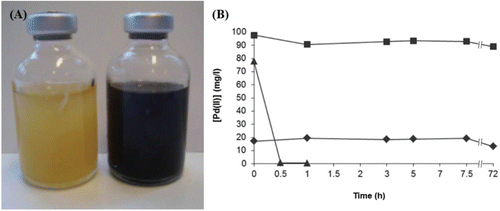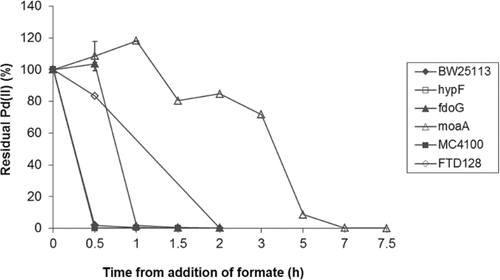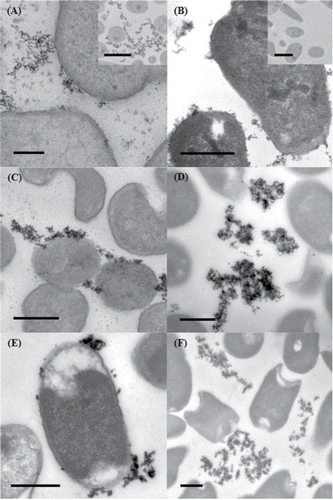Figures & data
Table 1. E. coli strains used to determine biological involvement in the reduction of palladium (II) using formate as the electron donor.
Figure 1. (A) Complete reduction of Pd(II) to Pd(0) by an aerobically grown culture of E. coli. Both bottles contain cells resuspended in 20 mM MOPS buffer at pH 7.6, and 1 mM sodium tetrachloropalladate (total volume 25 ml). This image was taken 45 min after the addition of formate to the bottle on the right. (B) Reduction by E. coli MC4100 and by controls showing no abiotic reduction of Pd(II). Controls used were killed (autoclaved) cells and cell-free suspension. Soluble Pd(II) in the supernatant was measured using ICP-MS. ▴ = MC4100; ■ = no cells; ♦ = killed cells.

Figure 2. EXAFS data showing the presence of Pd(II) at 0 and 30 min (bottom two traces), and Pd(0) at 1, 3 and 4 h (ascending series). The top trace is palladium foil.

Figure 3. Pd(II) reduction by six different strains of E. coli, using formate as the electron donor. Soluble Pd(II) in the supernatant was measured using ICP-MS. ♦ = BW25113; □ = JW2682; ▴ = JW3865; Δ = MC4100 ΔmoaA; ■ = MC4100; ◊ = FTD128. Data points for BW25113, JW2682 and JW3865 are mean values of triplicates, with standard error shown.

Figure 4. TEM of thin sections of aerobically grown cells showing extracellular palladium; (A) MC4100, inset BL21; (B) BW25113, inset BL21 (no Pd); (C) FTD128; (D) JW2682; (E) MC4100 ΔmoaA; (F) JW3865. Scale bar (A) = 100 nm; (B)-(F) = 500 nm; insets = 1 μm.

